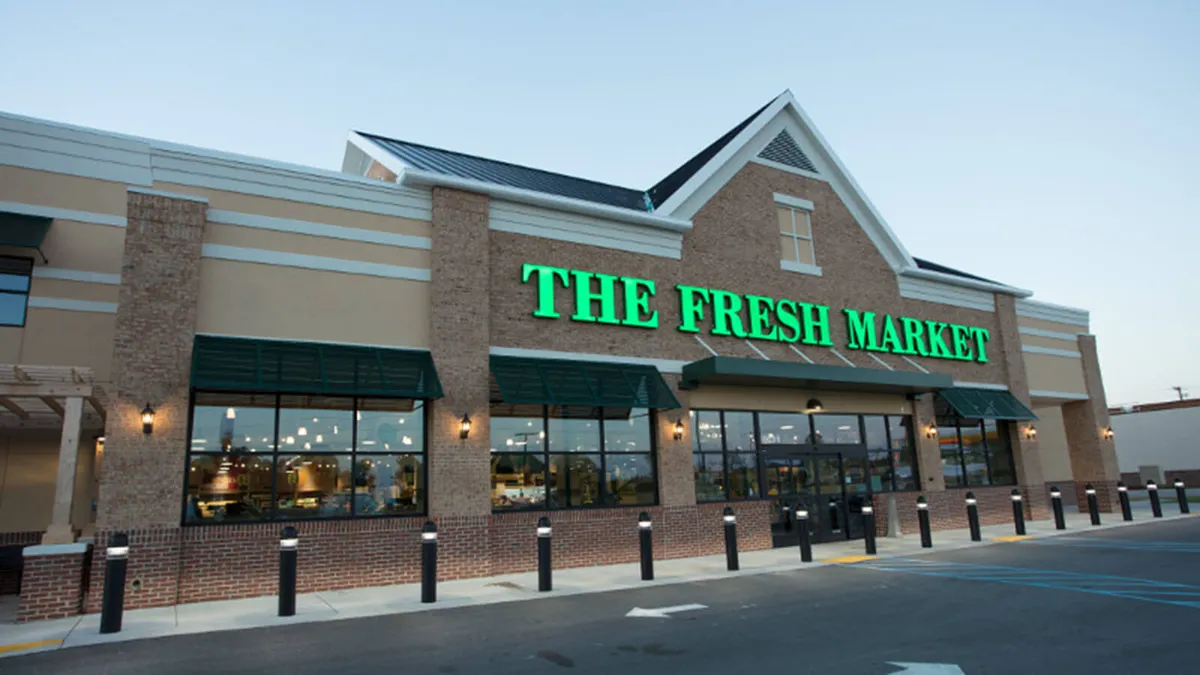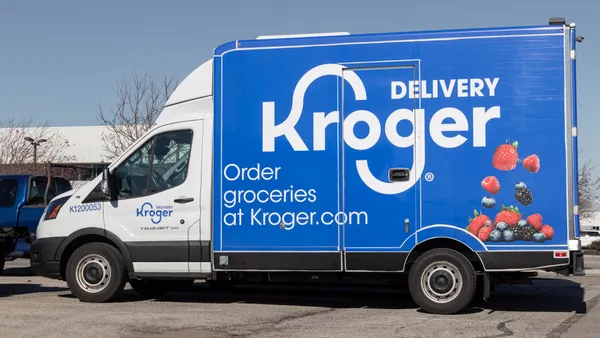UPDATE: July 21, 2021: The Fresh Market filed an S-1 form with the Securities and Exchange Commission on July 16 for an initial public offering. The specialty grocer chain said it intends to list stock on the Nasdaq under the symbol “TFM.”
In a note to potential shareholders, Jason Potter, president and CEO of the Greensboro, North Carolina-based grocer, said the company has made several changes after being acquired by private equity in 2016. Those changes include remerchandising to focus on premium fresh food, adding curated meals, making investments in omnichannel strategy and offering competitive pricing on staple items like bananas and milk.
“We believe The Fresh Market is positioned to capture the secular trend of consumer preference for higher-quality, fresh food,” Potter wrote.
The Fresh Market saw comparable store sales growth reach 22.3% in fiscal year 2020, up from -1.8% for FY 2019 and 0.4% for FY 2018, according to the filing. Comp sales growth was 7.3% for the first quarter of fiscal 2021, compared to 12.9% for the same period last year, with Potter noting the pandemic was partly behind the sales growth.
"With this offering, we will return to the public markets, which we believe will allow us significant flexibility in funding our strategy, including allowing us to refinance a significant portion of our debt," Potter wrote.
The price range of the initial public offering was not included in the filing.
Dive Brief:
- The Fresh Market has notified the Securities and Exchange Commission that it is considering becoming a publicly traded company, according to a press release from the grocery chain.
- The company filed its draft registration statement confidentially, which allows regulators to review the grocer's plans for a possible initial public offering privately.
- If The Fresh Market elects to press forward with its offering, it would mean a return to the public markets for the specialty chain nearly five years after it was acquired by private equity for $1.36 billion.
Dive Insight:
The Fresh Market’s performance has improved in the years since Apollo Global Management took it private, and the pandemic has accelerated the chain’s rejuvenation.
Now, it appears Apollo is eager to cash out of its investment by returning the grocery chain to the public market. The draft registration statement is an early and tentative step in the IPO process, allowing regulators to review company financials out of the public eye. The approach allows for flexibility in how, when and if a company decides to go public, with major companies Airbnb and Uber filing confidential paperwork ahead of their IPOs in recent years.
Southeastern Grocers filed a confidential draft registration statement with the SEC last fall on its way to a public offering that it pulled in January, reportedly due to a lack of demand.
The Fresh Market grew rapidly during its earlier stint as a public company, which lasted six years beginning in 2010. But it struggled against competitors like Whole Foods Market and Publix as it tried to appeal to a broader pool of shoppers. After Apollo acquired the grocer in 2016, company leadership reined in growth, closed dozens of stores and set about reestablishing it as a gourmet market for higher-income consumers.
Last March, The Fresh Market named Jason Potter, a cost-cutting specialist who spent 26 years working for Canada-based Sobeys, as CEO, replacing Larry Appel, who had initiated the chain’s strategic turn when he joined in 2017. In September, the company named Jim Heaney, a veteran of the cruise line and theme park industries, as chief financial officer.
That focused approach has put The Fresh Market on more solid financial footing, with credit rating firm Moody’s upgrading the company from “negative” to “stable” in fall 2019. And it has continued to improve during the pandemic as shoppers have plowed more of their food spending into grocery stores. In February, Moody’s upgraded the rating of the company’s senior secured notes to B3 from Caa1, indicating the grocer has improved its debt leverage, but is still considered a high credit risk. The Fresh Market’s debt is still high, Moody’s said, and is expected to be around a 5.4 times debt-to-earnings ratio over the next year or so.
The Fresh Market’s 2020 sales rose an estimated 20%, according to Moody’s, which noted the grocer has made notable investments in price, perishables and in expanding the availability of home delivery and pickup service. Moody’s estimated The Fresh Market had around $187 million in unrestricted cash as of late October and expects the company to be cash flow positive for the remainder of this year.
"Fresh Market's topline and EBITDA has demonstrated an improving trend since 2019 and got a further boost from pantry loading during the pandemic as consumers increased transaction sizes while lowering the number of trips to the store," Moody's Vice President Mickey Chadha said in a statement.
The Fresh Market's adjustments reflect a broader realignment happening in specialty grocery. After years of high-flying sales, operators are under pressure as supermarkets and discounters have boosted their specialty assortments. Last year saw bankruptcies from Lucky's Market, Earth Fare and Fairway Market, while Whole Foods has lagged behind other chains in generating foot traffic during the pandemic.
Despite The Fresh Market's improvements, Moody’s in its update cautioned that sales will slow as shopping habits normalize, and The Fresh Market will face increasing price pressure as promotional activity increases this year. The grocer operates in many competitive Southeastern markets, with conventional grocers as well as specialty chains and discounters upgrading their assortment of natural and organic products.










